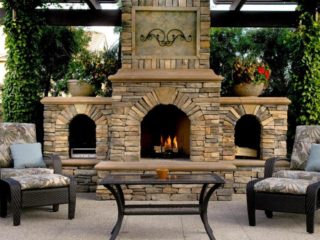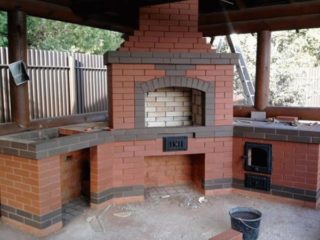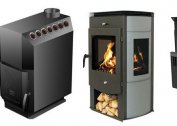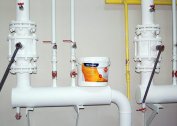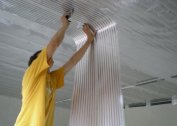There are many varieties of fireplace designs that are designed specifically for outdoor installation. Before choosing the most suitable fireplace option, it is advisable to familiarize yourself with the design features. Many users are also interested in the procedure for assembling it with their own hands.
Varieties of Outdoor Fireplaces
The following types of fireplace structures are distinguished:
- fireplace stove;
- built-in barbecue;
- Asian tandoor
- smokehouse;
- classic version.
An outdoor fireplace in the form of an oven is noteworthy in that it allows you to cook food in the open air with a high quality of its roasting. A distinctive feature of this design is the increased heat transfer rate, which forces to constantly monitor the combustion process. For this, the walls of the fireplace stoves are additionally insulated by forming voids filled with air.
Basic structural elements
Each of the varieties of fireplaces has its own distinctive features. The firebox of the built-in barbecue, for example, is made in the form of a volumetric bowl with vertical walls. Firewood is laid in it, and after their combustion, the formed coals are used for baking or smoking products. The Central Asian tandoor has a design that allows you to cook on the hot surface of the walls of the furnace.
The smokehouse stove differs from other samples in that its combustion chamber and food preparation compartment are separated into different zones. Due to this, the smoke formed after burning wood before entering the chimney passes through the cooking dish and smokes it.
A classic fireplace is a typical hearth, finished with stone or brick. Its firebox has advanced functionality: it can be used as a barbecue, barbecue, grill.
Materials used
As materials used in the construction of a street fireplace, traditionally used:
- brick;
- a rock;
- metal;
- concrete blocks.
In most cases, according to tradition, refractory or fireclay bricks are taken, but for some models they prefer to choose concrete blocks or natural stone as the masonry material. A typical fireplace in the yard can be independently made of metal blanks of the required thickness.
Choosing a place to install
Before building a street fireplace with your own hands, first of all, choose a place for its installation. At the same time, they proceed from considerations of functionality and take into account the safety of its operation. The most common recreation areas that are optimally suited for these purposes:
- country terrace;
- garden gazebo;
- open space in the countryside, selected in a calm place.
When installed on an open terrace, the chimney is attached directly to the wall of the house. In the gazebo, it is passed directly through the roof, in completely open structures the laying procedure and height are not limited by anything, except for the technical characteristics of the model.
Fireplace assembly
A step-by-step plan for the construction of the fireplace structure is compiled on the basis of the instruction, which gives various masonry options for each of its layers. In this case, the following work procedure is taken as a basis:
- arrangement of the foundation;
- main masonry;
- installation of the chimney.
At the final stage, they move on to decorating the fireplace. For these purposes, material selected at the discretion of the owner is used.
In accordance with the instructions given, they begin to build a fireplace on the street by laying the foundation for it, for which it will be necessary to do the following:
- Mark on a previously prepared place the contours of its location with a margin of 10 cm.
- Dig a pit to a depth of about 70 cm.
- Cover the bottom with rubble, and then carefully ram.
- Pour into it a sand-cement mortar prepared from one part of cement and 2 shares of sand, and then wait for it to dry.
In order for the foundation to be slightly raised above the ground, around the perimeter it will be necessary to prepare a formwork about 15 cm high and pour the base of the future pedestal with mortar. After this, a pause is made for about 3 days, until the solution completely hardens.
Main masonry
When laying out the base of the fireplace, it is necessary to strictly adhere to the design drawings, in which a diagram of each row is given. The procedure is as follows:
- On the surface of the concrete base in two layers is laid roofing material, used as a waterproofing.
- A solid brick row is laid out with a mandatory level check.
- Each next row is laid according to the scheme with a slight overlap of the previous one (with dressing).
- At the level of the grate, recesses are left in the walls to fix its protrusions.
Before installing the hinged door, its frame around the entire perimeter is laid with an asbestos cord, which allows to seal the interface.
Installation of a chimney chimney
The main functional purpose of the chimney is the removal of smoke from the combustion zone of solid fuel and the exclusion of it from falling into the space surrounding people. Due to the open position of the fireplace structure, the top of the chimney can be placed not very high. In this case, its arrangement is no different from the typical installation procedure and also requires a supporting structure - the roof of the arbor or the terrace wall.
Outdoor fireplace
A brick-built fireplace built by yourself on the street needs obligatory decorative decoration. There may be situations when masonry with well-crafted joints looks attractive in itself. If it is not done very carefully, you will need to close the untreated surfaces with a layer of plaster or trim them with artificial stone impaled on small fragments.
For applying hard coatings, elastic heat-resistant sealants are used, which provide reliable adhesion to the base at elevated temperatures. As finishing materials, it is not allowed to use structures having a significant coefficient of thermal expansion - plastic or wood.
